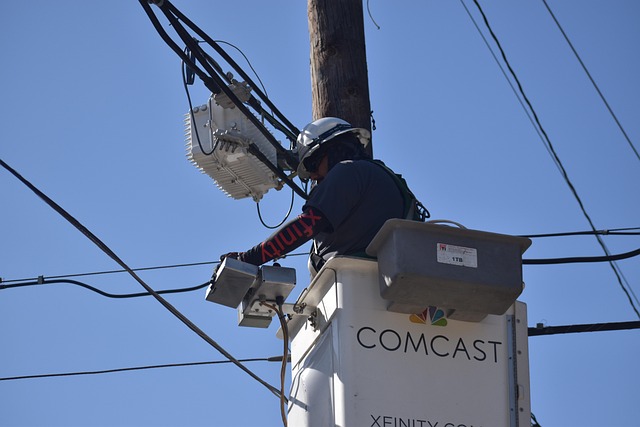In the events and conference sector, network cabling services are pivotal for delivering engaging audiovisual (AV) experiences. Event planners must tailor AV needs by evaluating equipment like projectors, sound systems, and microphones. They select cable types, lengths, and connectors based on venue size, audience capacity, and presentation complexity. The right network cabling services ensure seamless multimedia, collaboration, and communication, enhancing the overall event experience. Choosing between Cat5e, Cat6a, or fiber optic cables depends on requirements like high-definition video or international interpreting. Standardization and high-quality network cabling services simplify management and enhance performance. Regular testing, maintenance, and proactive measures ensure reliable, uninterrupted presentations.
In the dynamic landscape of modern events and conference rooms, seamless audio-visual (AV) integration is paramount. Effective AV cabling serves as the silent orchestrator behind successful meetings, ensuring every participant experiences content vividly and without interruption. This article explores the critical aspects of AV cabling for conference rooms and events, including understanding specific needs, leveraging network cabling services, implementing robust infrastructures, and maintaining optimal performance through rigorous testing.
Understanding AV Cabling Needs for Conference Rooms
In the dynamic world of conference rooms and events, Audio-Visual (AV) cabling plays a pivotal role in ensuring seamless connectivity and engaging experiences. Understanding the specific AV cabling needs is essential for optimal room functionality. This involves assessing the type of equipment employed, such as projectors, displays, sound systems, and microphones, to determine the required cable types, lengths, and connectors.
Event organizers and facilities managers should consider factors like room size, intended audience capacity, and the complexity of presentations or performances. For instance, larger conference halls may necessitate longer network cabling services for smooth multimedia transmission, while smaller meeting spaces might require more focused, customized cabling solutions. Efficient AV cabling ensures that technology enhances collaboration, facilitates clear communication, and creates an immersive environment for participants, ultimately elevating the overall event experience.
Types of Network Cabling Services for Events
When planning events or setting up conference rooms, one often overlooked but crucial aspect is the selection and installation of appropriate network cabling services. These services form the backbone of seamless audio-visual experiences, ensuring smooth connectivity between various devices like projectors, microphones, speakers, and computers. The most common types include Cat5e, Cat6a, and fiber optic cables, each catering to different bandwidth and distance requirements.
Event organizers should consider their specific needs, such as high-definition video transmission, multi-room connectivity, or simultaneous interpreting for international gatherings. Cat5e cabling, for instance, is suitable for basic data transfer and standard definition video, while Cat6a offers enhanced performance for 4K resolution and higher bandwidth applications. Fiber optic cables provide the highest speed and distance capabilities, making them ideal for large-scale events demanding low latency and reliable connections across extensive venues.
Best Practices for Implementing AV Infrastructure
Implementing an effective AV infrastructure for conference rooms and events requires careful planning and best practices to ensure seamless technology integration. One crucial aspect is standardization; defining a consistent setup across all spaces will simplify management and troubleshooting. This includes selecting suitable hardware, such as displays, projectors, and sound systems, that cater to the room’s size and intended use.
Additionally, prioritizing network cabling services is essential for reliable AV connectivity. High-quality cables and well-designed layouts ensure optimal signal transmission, reducing interference and signal loss. A robust networking infrastructure facilitates high-speed data transfer, crucial for handling large multimedia files and real-time streaming during events.
Ensuring Seamless Operations: Testing and Maintenance
Ensuring seamless operations in conference rooms and events heavily relies on proper audio-visual (AV) cabling and regular testing, maintenance, and troubleshooting by network cabling services. Regular checks are crucial to identify any potential issues before they disrupt presentations or performances. These tests can range from simple connections and signal strength checks to more complex scenario simulations, ensuring every component—from microphones and speakers to projectors and displays—functions optimally.
Network cabling services play a vital role in maintaining the integrity of AV systems. They employ specialized tools to verify cable connectivity, data transfer rates, and signal quality. Proactive maintenance, including periodic re-cabling and upgrades, extends equipment lifespans, enhances performance, and safeguards against unexpected failures during critical events. By prioritizing testing and maintenance, organizers can guarantee that their conference rooms and event spaces deliver reliable, high-quality audio and visual experiences for every participant.
When it comes to conference rooms and events, a reliable audio-visual (AV) infrastructure is paramount. By understanding your specific needs, leveraging the right network cabling services, and implementing best practices, you can ensure seamless operations that enhance collaboration and engagement. Regular testing and maintenance are crucial to keep up with evolving technology demands, guaranteeing a smooth experience for all participants. Investing in robust AV cabling solutions is a game-changer, enabling efficient event management and fostering productive meetings.
